Earlier this month, KISS guitarist Gene Simmons filed an application with the United States Patent and Trademark Office ("USPTO") to register the "devil's horns" hand gesture, which he routinely flashes at rock shows, as a trademark for "entertainment, namely, live performances by a musical artist; personal appearances by a musical artist." This bold move brings up a number of interesting questions, ranging from "Does the gesture really function as an indicator of source that points to Simmons?" to "How will he ever enforce it?" to "Can you really claim trademark rights in a hand gesture?" For a number of reasons, it will be surprising if Simmons actually manages to obtain a registration and use it to prevent others from flashing the horns, but his application does provide an amusing series of thought exercises.
The Application
The drawing of the mark in Simmons's application looks like this:
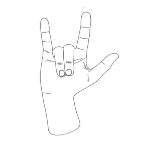
The application describes the mark as "a hand gesture with the index and small fingers extended upward and the thumb extended perpendicular." The application claims use of the mark in connection with the services since November 14, 1974, just after the release of Hotter Than Hell, and the specimen demonstrating how the mark is used in commerce consists of the following photograph:
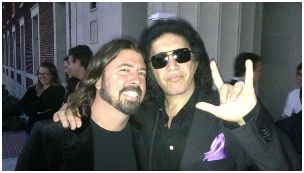
Yep, there he is, using the hand gesture arguably to identify himself as the source of this instance of "personal appearances by a musical artist" services. I mean, I'm not a member of the Kiss Army, but I can at least tell you which one is Gene Simmons in this photo, because he's the guy making the hand gesture. Source identification at work?
The Horns
A quick glance around the Internet suggests that Simmons may have a difficult time making the case – either to the USPTO or in enforcement contexts – that the "horns" gesture is not generic, and that he has used it substantially exclusively (such that it has acquired distinctiveness and he has not abandoned it through failure to police infringers). The Wikipedia article on "Sign of the Horns," for example, notes a number of other musicians who have used it, ranging from Ronnie James Dio of Black Sabbath to John Lennon, and refers to the sign's "common use in heavy metal music." (And as a proud Texan, I must point out that, outside of the music context, a horn hand gesture is also famous as the University of Texas Longhorns' "Hook 'em Horns" symbol. Indeed, UT president Greg Fenves has kicked off a lively debate on Twitter in the wake of Simmons's application.)
Even another pending trademark application seems to consider the gesture generic in relation to music: Eris Industries Ltd. has applied to register the image below in connection with various computer-related goods and services:

The applicant describes this mark as consisting of "a brown groundhog/marmot outlined in black and partially in white standing upright on its hind paws, with its right paw behind its back and its left paw to display the heavy metal sign of the horns hand gesture." Apparently, nobody told this marmot that he was flashing an arguably proprietary sign.
It is worth noting, however, that upon closer inspection, most of these instances of the "sign of the horns" differ from Simmons's claimed mark in that the thumb is not extended. Wikipedia describes the gesture as being formed "by extending the index and little fingers while holding the middle and ring fingers down with the thumb." Perhaps Simmons is taking the position that his gesture with the thumb extended is distinguishable from the no-thumb version, and that he therefore does not need to address the ubiquity of the latter.
The Precedents
Setting aside the question of whether Simmons's gesture actually does function as a trademark for his services, what about the more fundamental question of whether a hand gesture can act as a trademark? The Lanham Act provides for infringement remedies when a defendant uses a confusingly similar "word, term, name, symbol, or device" in connection with goods or services. Given that sounds and smells can be protected and registered as trademarks ( piña colada-scented ukuleles, anyone?), there appears to be no reason why a hand gesture could not count as a "symbol" or "device" that identifies the source of services, or perhaps even goods, if it is used at the point of sale.
There are, however, only 59 records in the USPTO database with the phrase "hand gesture" in the description of the mark, and the vast majority of them appear to be for logo marks containing an image of a hand gesture, rather than for the transitory hand gesture itself when made by a live person in the course of providing services or goods. Indeed, there is not one registered mark with "hand gesture" in the description that appears to claim rights in a hand gesture per se.
In one instance in which an applicant did appear to attempt to register an actual hand gesture, the PTO was resistant. In 2013, Lambda Tau Upsilon Christian Sorority applied to register a mark described as a hand gesture with the following drawing:
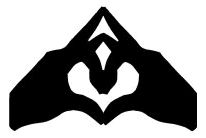
The services were "association services, namely, organizing chapters of a sorority and promoting the interests of members thereof," and the applicant submitted as the specimen a screen shot of its website featuring a photograph of people making the gesture shown in the drawing. The PTO issued an Office Action rejecting the specimen because it did not contain "a comparable drawing" as shown in the application (emphasis added). The Examining Attorney did not say explicitly that registration of a hand gesture per se was not permitted; rather he seems not to have even considered the possibility that that is what the applicant intended. The sorority responded to the Office Action by submitting a substitute specimen consisting of a photo of a t-shirt bearing the drawing of the hand gesture, but this was likewise rejected because a t-shirt did not show use in connection with association services. At that point, the sorority abandoned further attempts to register its hand gesture mark.
In addition to Simmons's application, there is one other pending application that may represent an attempt to register rights in a hand gesture per se. It is an intent-to-use application filed by Tan Cha – Hi Tea, Inc. for – guess what! – a thumbless "sign of the horns," in connection with "restaurant services, namely, providing of food and beverages for consumption on and off the premises":
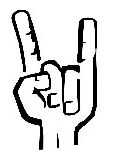
Since this is an intent-to-use application, there is no specimen to shed light on whether the applicant is actually claiming rights in a gesture to be flashed, for example, by servers when delivering beverages (rather than for the drawing of a hand making the gesture to be used on signage at the restaurant) but that certainly seems to be a plausible scenario.
If You Had to Pick a Visual "Trademark" for KISS...
Speaking of non-traditional marks, in case you were wondering, KISS does own a registration for a mark consisting of "face paint showing star overlaying eye." The drawing looks like this:

However, the registration does not cover entertainment services but rather "clothing namely, t-shirts, jackets and caps," and the three specimens that have been accepted over the years are as follows:
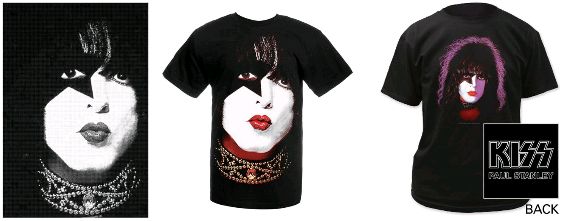
Once again, despite what the drawing and its description might suggest, it appears that the mark owner has shied away from actually attempting to register an aspect of personal appearance as a mark for services, in favor of registering a representation of that appearance as a mark for goods.
We look forward to seeing what becomes of Simmons's new application. In the meantime, ... Hook 'em Horns!
To view Foley Hoag's Trademark and Copyright Law Blog please click here
The content of this article is intended to provide a general guide to the subject matter. Specialist advice should be sought about your specific circumstances.

